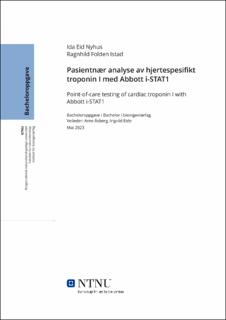| dc.contributor.advisor | Åsberg, Arne | |
| dc.contributor.advisor | Eide, Ingvild | |
| dc.contributor.advisor | Bach, Ragnhild | |
| dc.contributor.author | Istad, Ragnhild Folden | |
| dc.contributor.author | Nyhus, Ida Eid | |
| dc.date.accessioned | 2023-06-28T17:19:39Z | |
| dc.date.available | 2023-06-28T17:19:39Z | |
| dc.date.issued | 2023 | |
| dc.identifier | no.ntnu:inspera:146722497:148998051 | |
| dc.identifier.uri | https://hdl.handle.net/11250/3074113 | |
| dc.description.abstract | Hensikten med oppgaven var å undersøke analysekvaliteten og egenskapene til det pasientnære instrumentet Abbott i-STAT1. Dette ble gjennomført etter ønske fra Avdeling for medisinsk biokjemi, Seksjon Prøvetaking og Pasientnær Analyse ved St. Olavs hospital. Dersom kvaliteten på instrumentet viste seg å være god nok, kunne det vært aktuelt å gjennomføre en ny studie for å undersøke om instrumentet potensielt kunne blitt implementert i ambulansetjenesten og andre helsetjenester.
Testmetoden som ble undersøkt i prosjektet var cTnI-metoden på Abbott i-STAT1. Det ble gjennomført en metodesammenligning, presisjonsanalyse og en brukervennlighetsundersøkelse av denne. Referansemetoden var Elecsys Troponin T hs på Cobas 8000 e602. I prosjektet ble det undersøkt om de kliniske beslutningsgrensene for testmetoden og referansemetoden samsvarte, og om testmetoden hadde god nok presisjon for klinisk bruk. Siden det ble undersøkt to ulike proteiner, som ikke er direkte sammenlignbare, ble analyttenes kliniske beslutningsgrenser sammenlignet. Instrumentets brukervennlighet ble også undersøkt kvalitativt. Metodesammenligningen ble utført ved å analysere 43 prøver av heparinplasma, som tidligere var analysert med referansemetoden. Testmetodens presisjon ble vurdert gjennom en presisjonsanalyse av 20 paralleller. Prøven i presisjonsanalysen hadde en cTnT-konsentrasjon som det ble antatt at tilsvarte den kliniske beslutningsgrensen for testmetoden.
Metodesammenligningen viste at metodenes oppgitte kliniske beslutningsgrenser ikke samsvarte. Testmetoden hadde en dårligere klinisk sensitivitet enn referansemetoden, og ga flere falskt negative prøvesvar. Ved bruk av alternative kliniske beslutningsgrenser ble antall uoverensstemmende resultater mellom metodene redusert. Presisjonsanalysen viste at presisjonen var god nok for klinisk bruk. Den største utfordringen knyttet til brukervennlighet var mangel på plass i ambulansen. Ytre faktorer, som temperatur og bevegelse, så ikke ut til å påvirke analysesvarene i denne studien. Dersom cTnI på Abbott i-STAT1 skal implementeres ved St. Olavs hospital bør det vurderes bruk av egne alternative kliniske beslutningsgrenser. Det må også gjennomføres en større studie som omfatter bruk av instrumentet i ambulansetjenesten med fullblod som prøvemateriale. | |
| dc.description.abstract | The purpose of this thesis was to examine the analysis quality and characteristics of the point-of-care instrument Abbott i-STAT1. This was carried done at the request of Department of Clinical Chemistry at St. Olav´s Hospital. If the quality of the instrument turned out to be appropriate, it could be possible to do another study to investigate whether the instrument could potentially be implemented in the ambulance service and other institutions with similar needs.
The test method in question was the cTnI method on the Abbott i-STAT1. A method comparison, precision analysis and a user-friendliness survey were carried out. The reference method was Elecsys Troponin T hs on Cobas 8000 e602. In the project, it was investigated whether the clinical decision limits for the test method and the referance method corresponded, and whether the test method had sufficient precision for clinical use. Since the two examined proteins are not directly comparable, the analytes´clinical decision limits were compared. The instrument´s usability was also examined qualitatively. The method comparison was carried out by analyzing 43 samples of heparin plasma which had previously been analyzed with referance method. The test method´s precision was assessed through a precision analysis of 20 parallels. The sample in the precision analysis had a cTnT level that was assumed to correspond to the clinical decision limit of the test method.
The method comparison showed that the methods´stated clinical decision limits did not match. The test method had a poorer clinical sensitivity and produced more false negative test results than the reference method. By using alternative clinical decisions limits the number of discordant results between the methods was reduced. The precision analysis showed that the precision was good enough for clinical use. The greatest challenge related to user-friendliness was shortage of space in the ambulance. External factors, such as temperature and vibrations, did not appear to affect the analysis results in this study. If the cTnI method on Abbott i-STAT1 is to be implemented at St. Olav´s Hospital, the use of alternative clinical decision limits should be considered. A larger study must also be carried out that includes the use of the instrument in the ambulance service with whole blood as sample material. | |
| dc.language | nob | |
| dc.publisher | NTNU | |
| dc.title | Pasientnær analyse av hjertespesifikt troponin I med Abbott i-STAT1 | |
| dc.type | Bachelor thesis | |
